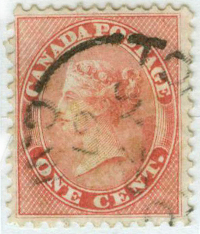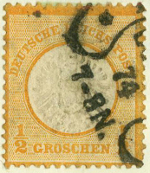
Discussion - Member to Member Sales - Research Center

Discussion - Member to Member Sales - Research Center

Do or did German proofers authenticate stamps by applying a small mark on one particular side of the genuine stamp and if it was not genuine, their mark was applied on the opposite side?
Thanks,
Bruce

Login to Like
this post
Hi Bruce,
Members of the prestigious Bund Philatelistischer Prüfer (BPP) follow a standardized practice when applying their markings. See here, scroll down to 6.5:
http://www.bpp.de/de/bpp-pruefordnung//
The point of putting the mark in a different position depending on if the stamp is used or unused, perforated, rouletted, or imperf., overprinted, or not, is to discourage fabrications from already examined stamps. I.e., one may have the idea of having a relatively inexpensive unused stamp examined and then adding a fake cancellation later to pass the stamp on as 'expertized.' I believe this system has been invented in the 1920s and has been promoted later by BPP. However, stamp experts and different organizations of stamp experts, never got on board globally. So, I am not sure if other organizations (AIEP etc.) also follow this scheme.
In any event, to answer your question, different positions of the expertizing mark by BPP (also VPP) affiliated expertizers are normal and indicate certain characteristics of the stamp. This should be double checked for accuracy to avoid picking up an altered stamp. If the stamp is fake, the marking is FALSCH.
Arno

Login to Like
this post
Arno, this is very interesting. Were these expertizing marks solely intended for German material, or did this extend to anything submitted to them?

Login to Like
this post
Ningpo,
Well, these are the binding examination guidelines all BPP affiliated experts follow. So, this is not just for the German material. A listing of current BPP experts with their areas of expertise is available on the BPP website (apparently in German only).
In my opinion, there is much to be said for this very thoughtful idea.
Arno

Login to Like
this post
I completely agree. A typically German methodical approach methinks.

Login to Like
this post
Thanks, Arno!
Bruce

Login to Like
this post
Members of the BPP can sign any stamp, but they may only issue certificates on particular areas of expertize. For example, the late Cornelia Brettl was expert in Helogland and Lubeck, so she issued certs for these, but she has signed other states.
LRM

1 Member
likes this post.
Login to Like.
Also if a German experts recieves a stamp with a higher value and sends you an Authentication the stamp itself will ussually not be marked. In the case of a forgery of fake cancel they will stamp the word "FALSCH" twice in an X fashion on back center of the stamp. Cost for sending in a false cancel is 5€.

1 Member
likes this post.
Login to Like.
Here an example of what Opa told:


4 Members
like this post.
Login to Like.
05:25:22pm
I'm not sure how this information found a place inside my head, but I was wondering if it is accurate.
Do or did German proofers authenticate stamps by applying a small mark on one particular side of the genuine stamp and if it was not genuine, their mark was applied on the opposite side?
Thanks,
Bruce

Login to Like
this post

re: Authentication of German Stamps By German Proofers
Hi Bruce,
Members of the prestigious Bund Philatelistischer Prüfer (BPP) follow a standardized practice when applying their markings. See here, scroll down to 6.5:
http://www.bpp.de/de/bpp-pruefordnung//
The point of putting the mark in a different position depending on if the stamp is used or unused, perforated, rouletted, or imperf., overprinted, or not, is to discourage fabrications from already examined stamps. I.e., one may have the idea of having a relatively inexpensive unused stamp examined and then adding a fake cancellation later to pass the stamp on as 'expertized.' I believe this system has been invented in the 1920s and has been promoted later by BPP. However, stamp experts and different organizations of stamp experts, never got on board globally. So, I am not sure if other organizations (AIEP etc.) also follow this scheme.
In any event, to answer your question, different positions of the expertizing mark by BPP (also VPP) affiliated expertizers are normal and indicate certain characteristics of the stamp. This should be double checked for accuracy to avoid picking up an altered stamp. If the stamp is fake, the marking is FALSCH.
Arno

Login to Like
this post

re: Authentication of German Stamps By German Proofers
Arno, this is very interesting. Were these expertizing marks solely intended for German material, or did this extend to anything submitted to them?

Login to Like
this post

re: Authentication of German Stamps By German Proofers
Ningpo,
Well, these are the binding examination guidelines all BPP affiliated experts follow. So, this is not just for the German material. A listing of current BPP experts with their areas of expertise is available on the BPP website (apparently in German only).
In my opinion, there is much to be said for this very thoughtful idea.
Arno

Login to Like
this post

re: Authentication of German Stamps By German Proofers
I completely agree. A typically German methodical approach methinks.

Login to Like
this post
11:31:31am
re: Authentication of German Stamps By German Proofers
Thanks, Arno!
Bruce

Login to Like
this post
06:51:14am
re: Authentication of German Stamps By German Proofers
Members of the BPP can sign any stamp, but they may only issue certificates on particular areas of expertize. For example, the late Cornelia Brettl was expert in Helogland and Lubeck, so she issued certs for these, but she has signed other states.
LRM

1 Member
likes this post.
Login to Like.

re: Authentication of German Stamps By German Proofers
Also if a German experts recieves a stamp with a higher value and sends you an Authentication the stamp itself will ussually not be marked. In the case of a forgery of fake cancel they will stamp the word "FALSCH" twice in an X fashion on back center of the stamp. Cost for sending in a false cancel is 5€.

1 Member
likes this post.
Login to Like.

re: Authentication of German Stamps By German Proofers
Here an example of what Opa told:


4 Members
like this post.
Login to Like.

